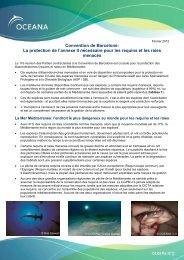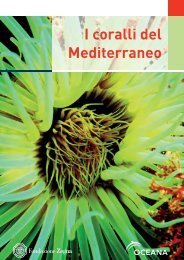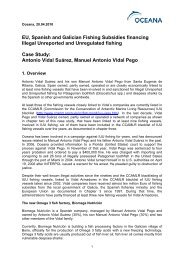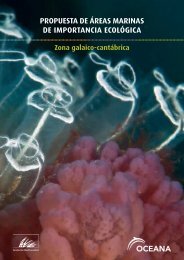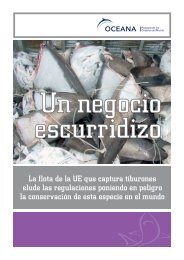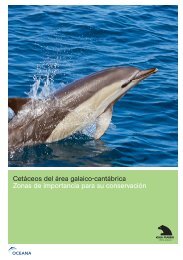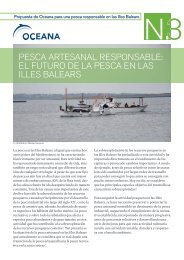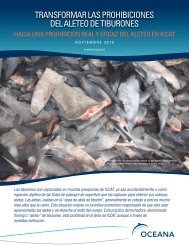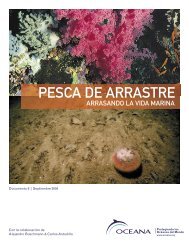Download - Oceana
Download - Oceana
Download - Oceana
You also want an ePaper? Increase the reach of your titles
YUMPU automatically turns print PDFs into web optimized ePapers that Google loves.
6. Community dominated by Alcyonium digitatum on infralittoral and circalittoral rocky bottom<br />
DESCRIPTION: In Galicia (Spain), some rocky areas of the infralittoral are covered by this species,<br />
forming up important micro-habitats. These areas are located in shallow waters around 40 m depth in the<br />
Rías Baixas. Also covering the rock we can find other cnidarians such as Corynactis viridis and several<br />
sponges species such as Cliona celata, Halichondria panicea, Haliclona cinerea, Hymeniacidon perlevis,<br />
Pleraplysilla spinifera and other unidentified desmosponges. The spiny starfish (Marthasterias glacialis) is<br />
also very common and abundant in this community.<br />
This community was documented around the Ven Island in the So Sound, from the central parts of the<br />
Kattegat, and at the Swedish coast in Northern Kattegat from stony bottom with boulders and soft<br />
sediments (mud, sand–mud). It is in the Baltic Sea between 17 and 38 meter depth. Alcyonium digitatum<br />
dominates the rocks and boulders. Sea urchins (Spatangus purpureus and Psammechinus miliaris) and<br />
brittle stars (Ophiura robusta, Ophiocomina nigra, Ophiura ophiura) are very abundant. Sea anemones<br />
(Metridium senile) and a number of hydroids are common. Macrophytes such as big kelps (Laminaria<br />
saccharina) and red algae (Delesseria sanguinea) are also common on shallower areas and these areas<br />
absent in deeper waters.<br />
This community dominated by Alcyonium digitatum was documented in deeper areas of this location (110-<br />
135m), in the central Kattegat, although the community is less abundant than in shallower areas. The<br />
sediments consist of mud with rocks and boulders on which Alcyonium digitatum was attached. The<br />
presence of echinoderm communities (particularly Brissopsis lyrifera and Echinus esculentus) is<br />
characteristic in this area when compared to the community in the shallower waters. Modiolus sp.<br />
community and burrowing worms (Arenicola marina) are also abundant among the rocks. Crustaceans<br />
were also more common than in the shallower waters.<br />
DEPTH: 17- 135 m<br />
TYPE OF SUBSTRATE: Rocky bottoms (rocky walls, boulders and stones). In the Baltic Sea, rocky<br />
subtrate where this community develops emerges on a soft sedimentary seabed dominated by mud and<br />
sand-mud.<br />
TYPICAL FLORA AND FAUNA OF THE COMMUNITY (Rías Baixas-Galicia, Spain)<br />
ALGAE<br />
Dictyota dichotoma Phyllariopsis purpurascens<br />
PORIFERA<br />
Cliona celata Haliclona cinerea<br />
Encrusted desmosponges Hymeniacidon perlevis<br />
Halichondria panicea Pleraplysilla spinifera<br />
CNIDARIA<br />
Aglaophenia sp. Leptogorgia sarmentosa<br />
Alcyonium glomeratum Parazoanthus axinellae<br />
Corynactis viridis<br />
BRYOZOA<br />
Pentapora fascialis<br />
MOLLUSCA<br />
Doriopsilla areolata<br />
ECHINODERMATA<br />
Aslia lefevrii Marthasterias glacialis<br />
CHORDATA: PISCES<br />
Gobiusculus flavescens<br />
45



